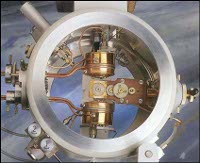TEM SPECIMEN PREPARATION
TEM Specimen Preparation
MFA, KFKI Campus, Building 25.
Contact: Árpád Barna, barna.arpad @ energia.mta.hu
Transmission electron microscopic specimens should be thin enough (tipically10 – 100 nm) for penetration of 100 – 200 kV electrons. This can beachieved by specific (chemical- or electropolishing) or universal (mechanical,ion beam) thinning methods. For heterogeneous samples – e.g. crosssectional specimens – only the latter techniques are suitable. In the MFAa range of special preparation methods and equipments have been developedand/or acquired based mainly on the ion milling method. In the following tablethe available equipments are listed according to the technological order of(cross sectional) specimen preparation which are of particular interest forprocessed semiconductor- and multilayer materials.
IV3 ion mill manufactured by
Technoorg-Linda Co

Wide application range in the field of Materials Science, Geology, Semiconductors and Optical Industry such as multilayer systems, semiconductors, high Tc supercon-ductors, diamond, composite materials, metals, ceramics, glasses, rocks, minerals.
• plan view and cross sectional specimens for TEM investigations
• slope cut specimens for SEM
Main features:
• Glancing angle bombardment (~1°) can be performed due to special sample holder design. Extreme surface smoothness can be achieved via low bombarding angles.
• Fast specimen exchange.
• Two independent, water-cooled ion guns operating at 2-10 kV. Easy maintenance.
• Dual beam modulation system for both side thinning also at different accelerating voltages.
• Extremely large area (>104 mm2), transparent regions are prepared.
• Retarding field operation (by a built-in high voltage unit) is a standard feature. By applying this method, bombarding angles below 1° can be achieved. The shadow free thinning of dimpled samples can also be carried out in this way.
• High milling rate (300 mm/hour at 30°for silicon can be achieved).
• Automatic or manual termination of ion milling upon perforation is possible.
Options:
• low energy ion gun
• liquid nitrogen cooling
• reactive ion milling